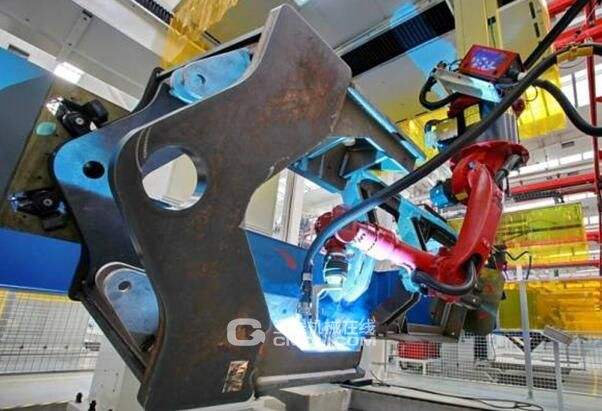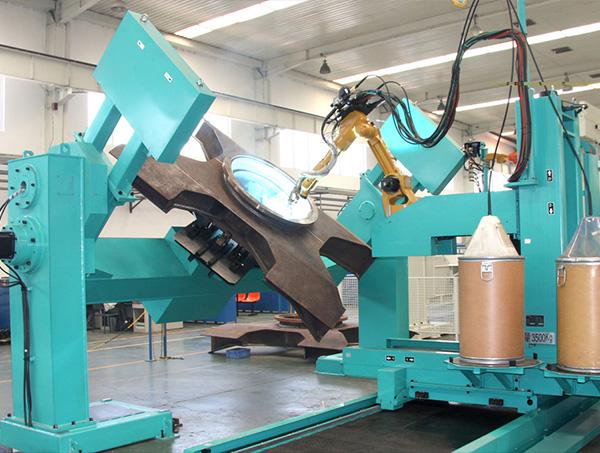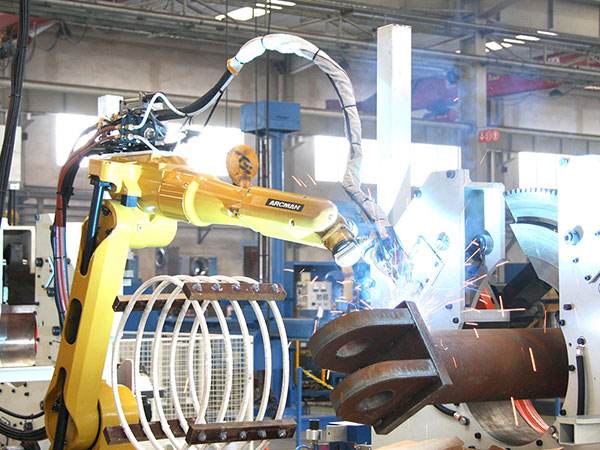With the development of reform and opening up in recent decades, great progress has been made in the manufacture of large welded steel structural parts in China. However, there is still a certain gap between China and developed countries, especially in the production of high strength steel plate, control systems and some key components. But Chinese manufacturers of large welded structural parts are trying to narrow the gap.
1. Challenges in Manufacturing and Production of Large Structural Parts in China
First, technological updates are changing rapidly. Generally speaking, large-scale structural parts have the highest profit in the initial stage of production, and decline rapidly after product maturity. Customers always want to get the most advanced products and are willing to pay more for them. This requires customers to constantly improve their design and manufacturing processes in order to improve their performance, thus bringing challenges to reduce production costs.
Second, the demand is changeable. In the sales of large-scale structural products, the change and cancellation of orders are common. Because of the unreliable market forecast, a large amount of material stock has to be reserved to overcome the change, which often leads to the scrap of materials. Especially for China's welded structural parts manufacturers, the fierce market competition, rapid market changes and rapid technological updates have challenged China's large welded structural parts manufacturers.
Third, the complex supply chain. The production, assembly and testing of large-scale structural parts is a multi-level and complex supply chain。The production of parts and components, assembly and testing must be synchronized. Some processing processes need to be outsourced, and there are many kinds and versions of products. This brings serious challenges to the fine management of large-scale structural parts production.
Fourthly, the capital intensity of large-scale structural parts manufacturing industry is high. For China large-scale structural parts manufacturing industry, it is necessary to establish high-standard factory buildings, and some sophisticated high-tech equipment needs huge investment. Different products need different special moulds, which are expensive, and the utilization ratio of equipment is more important than the utilization ratio of materials. Therefore, it is necessary to establish a reasonable product mix to improve the utilization ratio of overall equipment and maximize the effective output

2. Preparations for fabrication of large steel structural parts
2.1 The preparation of equipment, tools, site
According to the manufacturing process and characteristics of large-scale structural parts, it is necessary to have pertinence in the allocation of equipment and tools, equipped with professional equipment and workshop, which is conducive to the construction of production organization and production scale.
2.2 Process preparation
First, for products with relatively large quantity or precision requirements and interchangeable requirements, we should plan and design the jigs and tooling in advance, and the accuracy of jig and tooling is not lower than that of products; The second is to design the process flow;Third, do a good job in quality control procedures to ensure product quality, which is conducive to product fabrication guidance and supervision.
2.3 Materials preparation
According to the production plan, the materials arrived at workshop should be checked and accepted. The contents of checking and acceptance are the certificate of material qualification, rust removal, correction, checking specifications and quantities. After the checking work is completed, the material can be put into production. The acceptance of materials needs to meet the following general requirements: First, all the materials for manufacturing parts and components must have a certificate of qualifications of the manufacturer, otherwise it must be identified and tested, and can be used only after qualified; Second, the appearance quality inspection of sheets should meet the following criteria: (1). Visual inspection is generally used for the appearance quality inspection of products, that is, naked eye observation, if necessary, flaw detection, pickling, peeling and other means. (2) No visible cracks, slag inclusion, skin turning and other defects are allowed on the surface of the material. (3)The appearance quality of sheets and profiles should not only check whether there are any defects in their appearance, but also reach Grade B of GB8923 "Grade of Surface Corrosion and De-rusting of Steel before Coating",(4) For rusted sheets, profiles and other steels (mainly non-processed surfaces), surface treatment must be carried out before they can flow into the next process. Surface treatment of steels can be carried out by manual rust removal, shot blasting, chemical pickling and other methods, i.e. spraying to the surface close to whitening, with 95% of the area per unit area without visible residues.

3、Fabrication Process of large steel structural parts
The production process of large-scale structural parts is as follows: drawing & nest, cutting, assembling, welding, rectification, stress relief, machining and rust-proof paint.
3.1. Cutting preparation
(1) Shop drawing preparation and cutting parts nest
(2) CNC flame cutting or CNC Plasma cutting or CNC laser cutting
(3) Before cutting, the degree of steel deformation should be checked. If there is deformation, it should be corrected before cutting.
3.2 Cutting
(1) Before cutting, the corrosion and oil stain on the steel surface should be cleaned up. After cutting, there should be no cracks and no edges larger than 1.0 mm on the fracture surface, and the melt and spatter on the edge should be removed.
(2) The non-perpendicularity between the cutting surface and the steel surface is not more than 10% of the thickness of the steel plate and less than 2.0 mm.
(3) For mechanical shear parts, the allowable difference between the shear line and the number line shall not be greater than 2.0mm, and burrs shall be removed.
(4) For mechanically sheared section steel, the end shear slope shall not be greater than 2.0 mm, and burrs shall be removed.
(5) Alkyne or propane as gas automatic incision surface finish grade is divided into: excellent grade, first grade, second grade, third grade, fourth grade. Manual cutting can be divided into first, second and third levels, which are equal to the second, third and fourth levels of automatic cutting respectively (see Table 1). The smoothness of the incision is not less than one grade for automatic cutting and no less than two grades for manual cutting. Common low alloy steel should be cut by hand as far as possible.
Cutting quality shall comply with ISO 9013-2002 thermal cutting standard.
3.3、Assembly
(1) All pre-assembled components should be constructed according to drawings to ensure the size of drawings and processing allowance. The design datum should coincide with the datum of marking or mould. The actual datum of control components should be consistent with the design datum requirements. If the datum needs to be changed, it should be approved by the process.
(2) All parts for assembly must be inspected and corrected to conform to the requirements. Parts that do not conform to the specifications should not be assembled.
After the pre-assembly is completed, according to the relevant acceptance standards, it should be do self-inspection firstly; then it should be inspected and confirmed by a special inspector.
(3) Before assembling, rust, burr and oil contamination must be removed from the surface of the parts in the range of 30-500 mm along both sides of the weld.
(4) When assembling, the type of welding material used in tack welding(for position purpose) should be the same as that used in formal welding. The height of tack welding should not exceed 2/3 of the designed weld height and not exceed 8 mm, the length of weld seam should not be less than 25 mm. The position of positioning tack welding should be arranged within the weld seam and should be welded by qualified welders.
3.4、Welding
(1) Before welding wire and flux are used, they must be dried in accordance with relevant regulations. After baking, the low hydrogen type electrode should be placed in the heat preservation container to be used at will.
After welding, slag, metal spatter and strong-back must be removed. Welders should first check the quality of weld seams themselves and if there are obviously defects it should be repaired by welder self, and important weldments should be inspected by special quality inspectors after repairing.
(3) When a crack occurs in the weld, the welder shall not deal with it without authorization. The welder shall first report to the company's quality inspection or technical personnel, and the technical personnel shall find out the causes and work out the repair measures before they can deal with it.
(4) When the thickness of common structural steel plate is greater than 50mm and the low alloy structural steel plate is greater than or equal to 36mm, and the temperature of working place is not lower than O degree, the preheat treatment should be carried out.
(5) It is strictly forbidden to fill the gap with metal material for welding. The number of weld repairs in the same part should not exceed two times. When more than two times, it should be repaired according to the process.
3.5、Correction of deformation
When the degree of bending and distortion of components exceeds the requirements of the steel structure codes and design, it must be corrected. Welding deformation correction methods include mechanical correction, flame correction and mixed correction. When correcting, the measures can be reasonably selected according to the actual situation. Generally, the following principles should be followed: first overall, then partial; first primary, then secondary; first lower, then upper; first main, then secondary.
3.6、Elimination of welding stress
When the weld is cooled to room temperature, the tensile stress of the weld and the near weld in the whole joint area reaches a balance with the compressive stress of the base metal. At this time, the stress state is called welding residual stress, which is called welding stress. Large steel structural parts manufacturer often give priority to the control of welding deformation, and neglect the control of welding stress. However, due to the negative effects of residual stress on dynamic load, three-dimensional stress state and low temperature service of components, special attention should be paid to the control of welding residual stress. The purpose of controlling welding stress is to reduce its peak value and distribute it evenly. Control measures can be strengthened from the following aspects: minimizing weld size, reducing constraints on welded parts, adopting reasonable welding sequence, reducing stiffness of welded parts, and creating free shrinkage conditions.
Conclusion: At present, in China, large-scale structural parts of construction machinery are restricted by equipment capacity and technological level, which can not meet the needs of the development of related industries. This situation seriously restricts the rapid development of China's machinery manufacturers. Therefore, it is necessary for China's steel structure manufacturers to carry out research on the production and repair technology of large structural parts and product development.


